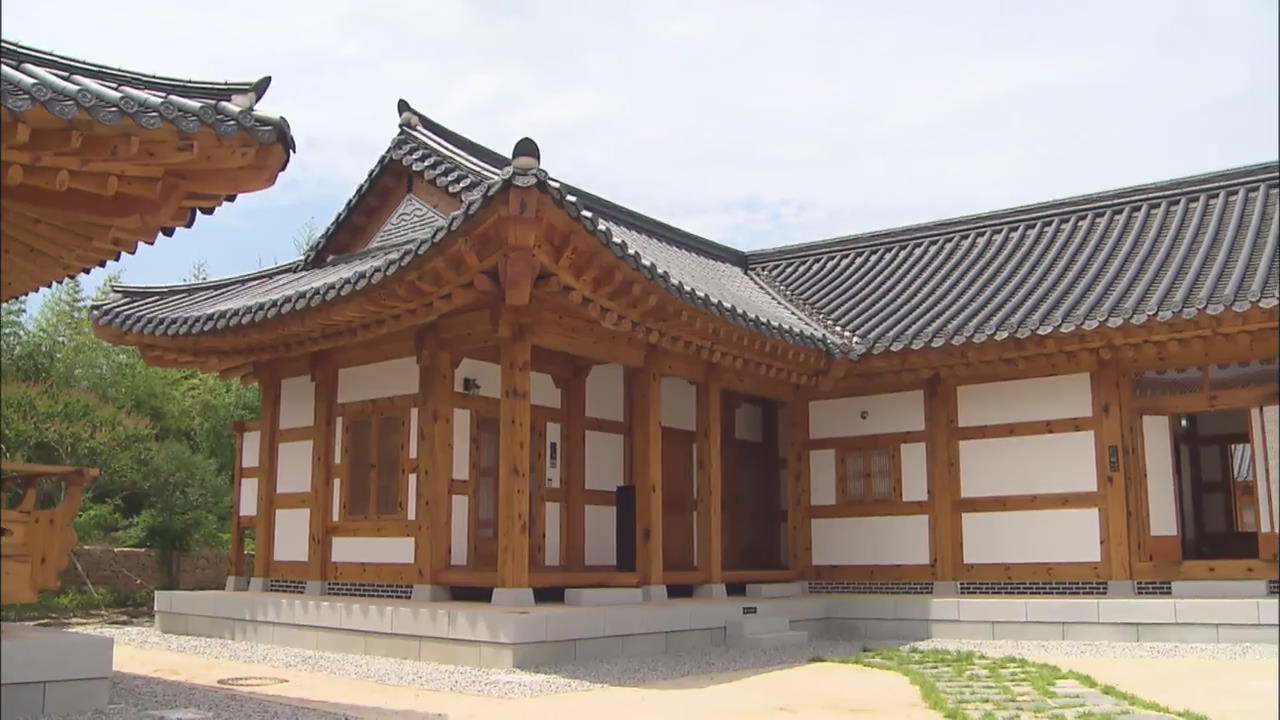Hanok Doors & Windows
입력 2016.11.11 (14:16)
수정 2016.11.11 (14:34)
읽어주기 기능은 크롬기반의
브라우저에서만 사용하실 수 있습니다.
[Anchor Lead]
In traditional Korean houses called "hanok," the unique doors and windows are an important factor that add to the beauty and elegance of the housing style. Let’s take a closer look.
[Pkg]
Traditional Korean housing hanok is known for various beautiful features. One of them is the unique doors and windows It's no exaggeration to say that the wooden muntins and window frames are like an artwork. They also contain the wisdom of Korean ancestors.
[Soundbite] Kim Jae-heon(Hanok Interior Designer) : "Hanji is excellent for insulation, since it effectively blocks cold air."
A KBS team visited a factory to find out how traditional doors and windows are produced. The first stage is to measure and shape out the wood. Hinges are made on a wood panel, and small holes are punched on another. This is for a traditional method that joins the two wood panels without the use of nails. It is necessary to treat the wood, a natural material that can rot easily. A sponge is used to get the vegetable oil to soak deep into the wood. The treatment is repeated five or six times to prevent the deformation of the wood over time. The next step is to paste traditional Korean paper "hanji" on the wood frames.
[Soundbite] Oh Taek-young(Traditional Door Maker) : "In order to preserve hanji's air permeability and moisture controlling function, we directly apply paste on to the frame and attach paper."
The last step is to assemble muntins on the frame. Hanji fades in about three years. So, staplers are used, instead of paste, to make it easy and convenient to replace the old paper with the new. It takes about a week to produce one traditional door or window. The effort takes the heart and soul of the person who makes it. In the past, people believed that gods as well as human beings used doors and windows. So they decorated doors and windows with various patterns. This pattern called "wanja" symbolizes eternity. This pattern resembling a turtle's back contains the hope for longevity and good health. With their simple but elegant beauty, traditional doors and windows are still loved by many people. So they are used in houses and apartments these days. As a legacy of Korean ancestors' wisdom, you too can add a tint of traditional Korean beauty to a contemporary home.
In traditional Korean houses called "hanok," the unique doors and windows are an important factor that add to the beauty and elegance of the housing style. Let’s take a closer look.
[Pkg]
Traditional Korean housing hanok is known for various beautiful features. One of them is the unique doors and windows It's no exaggeration to say that the wooden muntins and window frames are like an artwork. They also contain the wisdom of Korean ancestors.
[Soundbite] Kim Jae-heon(Hanok Interior Designer) : "Hanji is excellent for insulation, since it effectively blocks cold air."
A KBS team visited a factory to find out how traditional doors and windows are produced. The first stage is to measure and shape out the wood. Hinges are made on a wood panel, and small holes are punched on another. This is for a traditional method that joins the two wood panels without the use of nails. It is necessary to treat the wood, a natural material that can rot easily. A sponge is used to get the vegetable oil to soak deep into the wood. The treatment is repeated five or six times to prevent the deformation of the wood over time. The next step is to paste traditional Korean paper "hanji" on the wood frames.
[Soundbite] Oh Taek-young(Traditional Door Maker) : "In order to preserve hanji's air permeability and moisture controlling function, we directly apply paste on to the frame and attach paper."
The last step is to assemble muntins on the frame. Hanji fades in about three years. So, staplers are used, instead of paste, to make it easy and convenient to replace the old paper with the new. It takes about a week to produce one traditional door or window. The effort takes the heart and soul of the person who makes it. In the past, people believed that gods as well as human beings used doors and windows. So they decorated doors and windows with various patterns. This pattern called "wanja" symbolizes eternity. This pattern resembling a turtle's back contains the hope for longevity and good health. With their simple but elegant beauty, traditional doors and windows are still loved by many people. So they are used in houses and apartments these days. As a legacy of Korean ancestors' wisdom, you too can add a tint of traditional Korean beauty to a contemporary home.
■ 제보하기
▷ 카카오톡 : 'KBS제보' 검색, 채널 추가
▷ 전화 : 02-781-1234, 4444
▷ 이메일 : kbs1234@kbs.co.kr
▷ 유튜브, 네이버, 카카오에서도 KBS뉴스를 구독해주세요!
- Hanok Doors & Windows
-
- 입력 2016-11-11 14:17:06
- 수정2016-11-11 14:34:21

[Anchor Lead]
In traditional Korean houses called "hanok," the unique doors and windows are an important factor that add to the beauty and elegance of the housing style. Let’s take a closer look.
[Pkg]
Traditional Korean housing hanok is known for various beautiful features. One of them is the unique doors and windows It's no exaggeration to say that the wooden muntins and window frames are like an artwork. They also contain the wisdom of Korean ancestors.
[Soundbite] Kim Jae-heon(Hanok Interior Designer) : "Hanji is excellent for insulation, since it effectively blocks cold air."
A KBS team visited a factory to find out how traditional doors and windows are produced. The first stage is to measure and shape out the wood. Hinges are made on a wood panel, and small holes are punched on another. This is for a traditional method that joins the two wood panels without the use of nails. It is necessary to treat the wood, a natural material that can rot easily. A sponge is used to get the vegetable oil to soak deep into the wood. The treatment is repeated five or six times to prevent the deformation of the wood over time. The next step is to paste traditional Korean paper "hanji" on the wood frames.
[Soundbite] Oh Taek-young(Traditional Door Maker) : "In order to preserve hanji's air permeability and moisture controlling function, we directly apply paste on to the frame and attach paper."
The last step is to assemble muntins on the frame. Hanji fades in about three years. So, staplers are used, instead of paste, to make it easy and convenient to replace the old paper with the new. It takes about a week to produce one traditional door or window. The effort takes the heart and soul of the person who makes it. In the past, people believed that gods as well as human beings used doors and windows. So they decorated doors and windows with various patterns. This pattern called "wanja" symbolizes eternity. This pattern resembling a turtle's back contains the hope for longevity and good health. With their simple but elegant beauty, traditional doors and windows are still loved by many people. So they are used in houses and apartments these days. As a legacy of Korean ancestors' wisdom, you too can add a tint of traditional Korean beauty to a contemporary home.
In traditional Korean houses called "hanok," the unique doors and windows are an important factor that add to the beauty and elegance of the housing style. Let’s take a closer look.
[Pkg]
Traditional Korean housing hanok is known for various beautiful features. One of them is the unique doors and windows It's no exaggeration to say that the wooden muntins and window frames are like an artwork. They also contain the wisdom of Korean ancestors.
[Soundbite] Kim Jae-heon(Hanok Interior Designer) : "Hanji is excellent for insulation, since it effectively blocks cold air."
A KBS team visited a factory to find out how traditional doors and windows are produced. The first stage is to measure and shape out the wood. Hinges are made on a wood panel, and small holes are punched on another. This is for a traditional method that joins the two wood panels without the use of nails. It is necessary to treat the wood, a natural material that can rot easily. A sponge is used to get the vegetable oil to soak deep into the wood. The treatment is repeated five or six times to prevent the deformation of the wood over time. The next step is to paste traditional Korean paper "hanji" on the wood frames.
[Soundbite] Oh Taek-young(Traditional Door Maker) : "In order to preserve hanji's air permeability and moisture controlling function, we directly apply paste on to the frame and attach paper."
The last step is to assemble muntins on the frame. Hanji fades in about three years. So, staplers are used, instead of paste, to make it easy and convenient to replace the old paper with the new. It takes about a week to produce one traditional door or window. The effort takes the heart and soul of the person who makes it. In the past, people believed that gods as well as human beings used doors and windows. So they decorated doors and windows with various patterns. This pattern called "wanja" symbolizes eternity. This pattern resembling a turtle's back contains the hope for longevity and good health. With their simple but elegant beauty, traditional doors and windows are still loved by many people. So they are used in houses and apartments these days. As a legacy of Korean ancestors' wisdom, you too can add a tint of traditional Korean beauty to a contemporary home.
이 기사가 좋으셨다면
-
좋아요
0
-
응원해요
0
-
후속 원해요
0

















이 기사에 대한 의견을 남겨주세요.